Policies that are frequently included in a Code of Conduct
In this chapter, we’ll learn about some policies that are frequently found in a code of conduct. In particular, most modern codes of conduct include information on what an employee can say or do online.

Substance Use Code of Conduct Policies
Most companies have rules prohibiting the use of alcohol and the unlawful use of drugs in the workplace. A substance and abuse policy typically includes rules prohibiting employees from possessing, selling, purchasing, or transferring illegal drugs while on company premises or operating company vehicles.

Abusive Conduct and Bullying Policies
Policies prohibiting abusive conduct and bullying are common in a code of conduct. This could include unwanted aggressive behavior, an observed or perceived power imbalance, repetition or the high likelihood of repetition of the aggressive behaviors, ulgar or obscene remarks, jokes, posters or cartoons, and any unwelcome touching, pinching or other physical contact

Let's take a look at a few more code of conduct policies.
Giving and receiving items of value between employees and third parties can create issues for companies since these actions might influence business decisions. Many organizations have policies that set rules for the value amounts that may be given or accepted. Policies vary, so be sure to check your organization's.
A conflict of interest occurs if you are involved in an activity or a relationship that could influence the decisions you make in your job. Bribery and corruption are examples of conflicts of interest.
Employers want to pay their employees for the time that they actually work. Therefore, time and attendance policies often state that the hours an employee reports must match the actual hours worked and be during the employee's designated work schedule. Policies usually include the consequences for falsifying or failing to report work hours accurately.

Digital policies in a code of conduct
Our world is a digital one, so it is no surprise that companies have policies in place regarding cybersecurity and digital services. Organizations typically have rules in place regarding email and cell phone use, plus the usage of digital platforms such as Slack, Skype for Business, and Zoom as a means of electronically communicating instantly and face-to-face. Social media use policies have also become a part of codes of conduct for many companies. In some cases, these rules could apply to posts made outside of the workplace as well.
Discrimination and Harassment
Most organizations have a discrimination and harassment policy in their code of conduct that follows federal laws. According to the U.S. Equal Employment Opportunity Commission (the EEOC), it is illegal to discriminate against employees and former employees based on specific personal traits. These traits are referred to as protected characteristics or protected classes and include:
Here are some myths to look out for:
- -
Race
- -
Color
- -
Religion
- -
Sex (including pregnancy, sexual orientation, and gender identity)
- -
National origin
- -
Age (40 or older)
- -
Disability
- -
Genetic information (including family medical history)

Learn Why it’s vital to follow Policies with code of conduct training
EasyLlama's Code of Conduct course uses our modern training platform with interactive quizzes and real-life video scenarios to educate on the many types of policies out there. Employees and employers should know their company’s rules for all forms of communication and remember to always be aware of their actions while using any electronic device.

Helping over 8,000 organizations create a safer, more productive workplace
With EasyLlama training, your employees will discover how to be more aware of discrimination, bias in the workplace, and reap the benefits of a diverse and inclusive workforce. Here are some of the topics covered in our course:





















